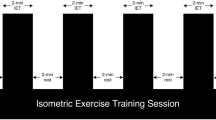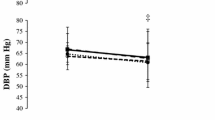Abstract
Objectives
Acute cardiovascular responses following a single session of isometric exercise (IE) have been shown to predict chronic adaptations in blood pressure (BP) regulation. It was hypothesised that exercises which recruit more muscle mass induce greater reductions in BP compared to exercises using smaller muscle mass. To test this hypothesis, the current study aimed to compare the acute haemodynamic and autonomic responses to a single session of isometric wall squat (IWS) and isometric handgrip (IHG) training.
Methods
Twenty-six sedentary participants performed a single IWS and IHG session in a randomised cross-over design, with training composed of 4 × 2-min contractions, with 2-min rest, at 95 HRpeak and 30% MVC respectively. Haemodynamic and cardiac autonomic variables were recorded pre, during, immediately post, and 1-h post-exercise, with the change from baseline for each variable used for comparative analysis.
Results
During IWS exercise, there was a significantly greater increase in systolic BP (P < 0.001), diastolic BP (P < 0.001), mean BP (P < 0.001), heart rate (P < 0.001), and cardiac output (P < 0.001), and a contrasting decrease in baroreflex effectiveness index (BEI) and cardiac baroreceptor sensitivity (cBRS). In the 10-min recovery period following IWS exercise, there was a significantly greater reduction in systolic BP (P = 0.005), diastolic BP (P = 0.006), mean BP (P = 0.003), total peripheral resistance (TPR) (P < 0.001), BEI (P = 0.003), and power spectral density (PSD-RRI) (P < 0.001). There were no differences in any variables between conditions 1-h post exercise.
Conclusions
Isometric wall squat exercise involving larger muscle mass is associated with a significantly greater post-exercise hypotensive response during a 10-min recovery window compared to smaller muscle mass IHG exercise. The significantly greater reduction in TPR may be an important mechanism for the differences in BP response.



Similar content being viewed by others
References
Al Tunaiji H, Davis JC, Mansournia MA, Khan KM (2019) Population attributable fraction of leading non-communicable cardiovascular diseases due to leisure-time physical inactivity: a systematic review. BMJ Open Sport Exerc Med. https://doi.org/10.1136/bmjsem-2019-000512
Badrov MB, Horton S, Millar PJ, Mcgowan CL (2013) Cardiovascular stress reactivity tasks successfully predict the hypotensive response of isometric handgrip training in hypertensives. Psychophysiology. https://doi.org/10.1111/psyp.12031
Bentley DC, Nguyen CH, Thomas SG (2018) Resting blood pressure reductions following handgrip exercise training and the impact of age and sex: a systematic review and narrative synthesis. Syst Rev. https://doi.org/10.1186/s13643-018-0876-5
Billman GE (2013) The LF/HF ratio does not accurately measure cardiac sympatho-vagal balance. Front Physiol. https://doi.org/10.3389/fphys.2013.00026
Borg GAV (1982) Psychophysical bases of perceived exertion. Med Sci Sports Exerc 14(5):377–381
Carlson DJ, Dieberg G, Hess NC et al (2014) Isometric exercise training for blood pressure management: a systematic review and meta-analysis. Mayo Clin Proc. https://doi.org/10.1016/j.mayocp.2013.10.030
Casonatto J, Goessler KF, Cornelissen VA et al (2016) The blood pressure-lowering effect of a single bout of resistance exercise: a systematic review and meta-analysis of randomised controlled trials. Eur J Prev Cardiol. https://doi.org/10.1177/2047487316664147ejpc.sagepub.com
Cornelissen VA, Smart NA (2013) Exercise training for blood pressure: a systematic review and meta-analysis. J Am Heart Assoc. https://doi.org/10.1161/JAHA.112.004473
Devereux GR, Wiles JD, Swaine IL (2010) Reductions in resting blood pressure after 4 weeks of isometric exercise training. Eur J Appl Physiol. https://doi.org/10.1007/s00421-010-1394-x
Di Rienzo M, Parati G, Castiglioni P et al (2001) Baroreflex effectiveness index: An additional measure of baroreflex control of heart rate in daily life. Am J Physiol Regul Integr Comp Physiol. https://doi.org/10.1152/ajpregu.2001.280.3.r744
Fagius J, Karhuvaara S (1989) Sympathetic activity and blood pressure increases with bladder distension in humans. Hypertension. https://doi.org/10.1161/01.HYP.14.5.511
Farah B, Germano-Soares A, Rodrigues S et al (2017) Acute and chronic effects of isometric handgrip exercise on cardiovascular variables in hypertensive patients: a systematic review. Sports. https://doi.org/10.3390/sports5030055
Farah BQ, Christofaro DGD, Correia MA et al (2020) Effects of isometric handgrip training on cardiac autonomic profile: a systematic review and meta-analysis study. Clin Physiol Funct Imaging. https://doi.org/10.1111/cpf.12619
Field A (2013) Discovering statistics using IBM SPSS statistics
Fortin J, Habenbacher W, Gruellenberger R et al (2002). Real-Time Monitor for Hemodynamic Beat-to-Beat Parameters and Power Spectra Analysis of the Biosignals. https://doi.org/10.1109/IEMBS.1998.745917
Fortin J, Haitchi G, Bojic A, et al (2001) Validation and Verification of the Task Force® Monitor. FDA Pap
Gálvez JM, Alonso JP, Sangrador LA, Navarro G (2000) Effect of muscle mass and intensity of isometric contraction on heart rate. J Appl Physiol. https://doi.org/10.1152/jappl.2000.88.2.487
Gliemann L, Vestergaard Hansen C, Rytter N, Hellsten Y (2019) Regulation of skeletal muscle blood flow during exercise. Curr Opin Physiol. https://doi.org/10.1016/j.cophys.2019.05.001
Goldring N, Wiles JD, Coleman D (2014) The effects of isometric wall squat exercise on heart rate and blood pressure in a normotensive population. J Sports Sci. https://doi.org/10.1080/02640414.2013.809471
Green DJ, Hopman MTE, Padilla J et al (2017) Vascular adaptation to exercise in humans: role of hemodynamic stimuli. Physiol Rev. https://doi.org/10.1152/physrev.00014.2016
Hellsten Y, Nyberg M, Jensen LG, Mortensen SP (2012) Vasodilator interactions in skeletal muscle blood flow regulation. J Physiol. https://doi.org/10.1113/jphysiol.2012.240762
Hesse C, Charkoudian N, Liu Z et al (2007) Baroreflex sensitivity inversely correlates with ambulatory blood pressure in healthy normotensive humans. Hypertension. https://doi.org/10.1161/HYPERTENSIONAHA.107.090308
Hopf HB, Skyschally A, Heusch G, Peters J (1995) Low-frequency spectral power of heart rate variability is not a specific marker of cardiac sympathetic modulation. Anesthesiology. https://doi.org/10.1097/00000542-199503000-00002
Hopkins WG (2000) A new view of statistics: P values. Internet Soc Sport Sci
Iellamo F, Pizzinelli P, Massaro M et al (1999) Muscle metaboreflex contribution to sinus node regulation during static exercise: insights from spectral analysis of heart rate variability. Circulation. https://doi.org/10.1161/01.CIR.100.1.27
Inder JD, Carlson DJ, Dieberg G et al (2016) Isometric exercise training for blood pressure management: a systematic review and meta-analysis to optimize benefit. Hypertens Res. https://doi.org/10.1038/hr.2015.111
Johansson M, Gao SA, Friberg P et al (2007) Baroreflex effectiveness index and baroreflex sensitivity predict all-cause mortality and sudden death in hypertensive patients with chronic renal failure. J Hypertens. https://doi.org/10.1097/01.hjh.0000254377.18983.eb
Joyner MJ, Casey DP (2015) Regulation of increased blood flow (hyperemia) to muscles during exercise: a hierarchy of competing physiological needs. Physiol Rev. https://doi.org/10.1152/physrev.00035.2013
Keselbrener L, Akselrod S (1996) Selective discrete Fourier transform algorithm for time-frequency analysis: method and application on simulated and cardiovascular signals. IEEE Trans Biomed Eng. https://doi.org/10.1109/10508542
La Rovere MT, Bersano C, Gnemmi M et al (2002) Exercise-induced increase in baroreflex sensitivity predicts improved prognosis after myocardial infarction. Circulation. https://doi.org/10.1161/01.CIR.0000027565.12764.E1
Liu S, Goodman J, Nolan R et al (2012) Blood pressure responses to acute and chronic exercise are related in prehypertension. Med Sci Sports Exerc. https://doi.org/10.1249/MSS.0b013e31825408fb
Lohmeier TE, Irwin ED, Rossing MA et al (2004) Prolonged activation of the baroreflex produces sustained hypotension. Hypertension. https://doi.org/10.1161/01.HYP.0000111837.73693.9b
López-Valenciano A, Ruiz-Pérez I, Ayala F et al (2019) Updated systematic review and meta-analysis on the role of isometric resistance training for resting blood pressure management in adults. J Hypertens. https://doi.org/10.1097/HJH.0000000000002022
McGowan CL, Levy AS, Millar PJ et al (2006) Acute vascular responses to isometric handgrip exercise and effects of training in persons medicated for hypertension. Am J Physiol - Hear Circ Physiol. https://doi.org/10.1152/ajpheart.01113.2005
McGowan CL, Levy AS, McCartney N, MacDonald MJ (2007a) Isometric handgrip training does not improve flow-mediated dilation in subjects with normal blood pressure. Clin Sci. https://doi.org/10.1042/CS20060195
McGowan CL, Visocchi A, Faulkner M et al (2007b) Isometric handgrip training improves local flow-mediated dilation in medicated hypertensives. Eur J Appl Physiol. https://doi.org/10.1007/s00421-006-0337-z
Medicine AC of S (2016) ACSM’s guidelines for exercise testing and prescription. Lippincott Williams & Wilkins
Millar PJ, MacDonald MJ, Bray SR, McCartney N (2009) Isometric handgrip exercise improves acute neurocardiac regulation. Eur J Appl Physiol. https://doi.org/10.1007/s00421-009-1142-2
Millar PJ, McGowan CL, Cornelissen VA et al (2014) Evidence for the role of isometric exercise training in reducing blood pressure: Potential mechanisms and future directions. Sport Med. https://doi.org/10.1007/s40279-013-0118-x
Minahan C, O’Neill H, Sikkema N, et al (2018) Oral contraceptives augment the exercise pressor reflex during isometric handgrip exercise. Physiol Rep https://doi.org/10.14814/phy2.13629
Morgan WP (1994) Psychological components of effort sense. Med Sci Sports Exerc. https://doi.org/10.1249/00005768-199409000-00001
Olher RR, Rosa TS, Souza LHR et al (2020) Isometric exercise with large muscle mass improves redox balance and blood pressure in hypertensive adults. Med Sci Sports Exerc. https://doi.org/10.1249/MSS.0000000000002223
Owen A, Wiles J, Swaine I (2010) Effect of isometric exercise on resting blood pressure: a meta analysis. J Hum Hypertens. https://doi.org/10.1038/jhh.2010.13
Parati G, DiRienzo M, Mancia G (2000) How to measure baroreflex sensitivity: from the cardiovascular laboratory to daily life. J Hypertens 18(1):7–19
Pichon AP, De Bisschop C, Roulaud M et al (2004) Spectral analysis of heart rate variability during exercise in trained subjects. Med Sci Sports Exerc. https://doi.org/10.1249/01.MSS.0000142403.93205.35
Pomeranz B, Macaulay JB, Caudill MA (1985) Assessment of autonomic functions in humans by heart rate spectral analysis. Am J Physiol - Hear Circ Physiol. https://doi.org/10.1152/ajpheart.1985.248.1.h151
Ray CA, Carrasco DI (2000) Isometric handgrip training reduces arterial pressure at rest without changes in sympathetic nerve activity. Am J Physiol Hear Circ Physiol. https://doi.org/10.1152/ajpheart.2000.279.1.h245
Rowell LB, O’Leary DS (1990) Reflex control of the circulation during exercise: chemoreflexes and mechanoreflexes. J Appl Physiol. https://doi.org/10.1152/jappl.1990.69.2.407
Seals DR (1989) Influence of muscle mass on sympathetic neural activation during isometric exercise. J Appl Physiol. https://doi.org/10.1152/jappl.1989.67.5.1801
Sharma R, O’Driscoll JM, Saha A et al (2015) Differing autonomic responses to dobutamine stress in the presence and absence of myocardial ischaemia. J Physiol. https://doi.org/10.1113/JP270063
Silva JKTNF, Menêses AL, Parmenter BJ et al (2021) Effects of resistance training on endothelial function: a systematic review and meta-analysis. Atherosclerosis. https://doi.org/10.1016/j.atherosclerosis.2021.07.009
Smart NA, Way D, Carlson D et al (2019) Effects of isometric resistance training on resting blood pressure: individual participant data meta-analysis. J Hypertens. https://doi.org/10.1097/HJH.0000000000002105
Somani YB, Baross AW, Brook RD et al (2018) Acute response to a 2-minute isometric exercise test predicts the blood pressure-lowering efficacy of isometric resistance training in young adults. Am J Hypertens. https://doi.org/10.1093/ajh/hpx173
Taylor KA, Wiles JD, Coleman DD et al (2017) Continuous cardiac autonomic and hemodynamic responses to isometric exercise. Med Sci Sports Exerc. https://doi.org/10.1249/MSS.0000000000001271
Taylor KA, Wiles JD, Coleman DA et al (2019) Neurohumoral and ambulatory haemodynamic adaptations following isometric exercise training in unmedicated hypertensive patients. J Hypertens. https://doi.org/10.1097/HJH.0000000000001922
Valipour A, Schneider F, Kössler W et al (2005) Heart rate variability and spontaneous baroreflex sequences in supine healthy volunteers subjected to nasal positive airway pressure. J Appl Physiol. https://doi.org/10.1152/japplphysiol.00003.2005
Vischer AS, Burkard T (2017) Principles of blood pressure measurement – current techniques, office vs ambulatory blood pressure measurement. Adv Exp Med Biol. https://doi.org/10.1007/5584_2016_49
Whelton PK, Carey RM, Aronow WS et al (2018) 2017 ACC/AHA/AAPA/ABC/ACPM/AGS/APhA/ASH/ASPC/NMA/PCNA guideline for the prevention, detection, evaluation, and management of high blood pressure in adults: executive summary. J Am Soc Hypertens. https://doi.org/10.1016/j.jash.2018.06.010
Wiles JD, Coleman DA, Swaine IL (2010) The effects of performing isometric training at two exercise intensities in healthy young males. Eur J Appl Physiol. https://doi.org/10.1007/s00421-009-1025-6
Wiles JD, Goldring N, Coleman D (2017) Home-based isometric exercise training induced reductions resting blood pressure. Eur J Appl Physiol. https://doi.org/10.1007/s00421-016-3501-0
Wiles JD, Taylor K, Coleman D et al (2018) The safety of isometric exercise: Rethinking the exercise prescription paradigm for those with stage 1 hypertension. Med (united States). https://doi.org/10.1097/MD.0000000000010105
Williams B, Mancia G, Spiering W et al (2018) 2018 Practice guidelines for the management of arterial hypertension of the European Society of Hypertension (ESH) and the European Society of Cardiology (ESC). Blood Press. https://doi.org/10.1080/08037051.2018.1527177
Acknowledgements
None.
Funding
None.
Author information
Authors and Affiliations
Corresponding author
Ethics declarations
Conflict of interest
None.
Additional information
Communicated by Ellen Adele Dawson.
Publisher's Note
Springer Nature remains neutral with regard to jurisdictional claims in published maps and institutional affiliations.
Supplementary Information
Below is the link to the electronic supplementary material.
Rights and permissions
About this article
Cite this article
Swift, H.T., O’Driscoll, J.M., Coleman, D.D. et al. Acute cardiac autonomic and haemodynamic responses to leg and arm isometric exercise. Eur J Appl Physiol 122, 975–985 (2022). https://doi.org/10.1007/s00421-022-04894-7
Received:
Accepted:
Published:
Issue Date:
DOI: https://doi.org/10.1007/s00421-022-04894-7




